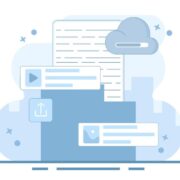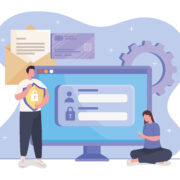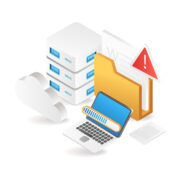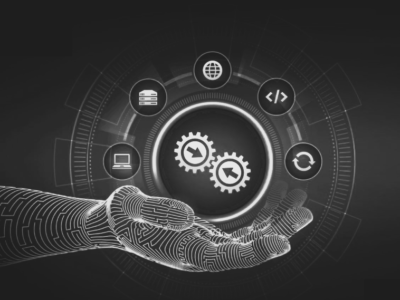Table of Contents
Defining Cloud Monitoring in the Cloud-Native Era
Cloud monitoring software refers to tools and practices for observing and managing cloud-based infrastructure – from applications and containers to services across public, private, and hybrid clouds. It provides continuous visibility into system health by collecting metrics, logs, and traces in real time. This visibility is critical in modern cloud-native, multi-cloud, and hybrid cloud environments where applications run as distributed microservices. As businesses scale their digital footprint, cloud observability tools give DevOps and SRE teams the real-time cloud analytics and automation needed to optimize performance and user experience.
In today’s deployments, the benefits of cloud monitoring in multi-cloud environments are clear – it delivers unified insights and hybrid cloud visibility across platforms, helping prevent downtime and performance bottlenecks. Notably, multi-cloud has become the norm for enterprises: in 2023, 76% of organizations used a multi-cloud strategy. As multi-cloud adoption continues to grow, more than 90% of organizations are now utilizing some form of cloud environment. Flexera’s 2024 “State of the Cloud” survey reveals that 97% of IT professionals intend to implement a multi-cloud system within the next year.
Cloud monitoring provides a single pane of glass to manage such diversity, correlating telemetry from on-prem data centers, multiple public clouds, and edge locations. It has evolved beyond basic uptime checks to a cloud-native observability approach that integrates AI, automation, and security telemetry for comprehensive insight. In short, cloud monitoring software is the nervous system of cloud-native operations – supporting SRE best practices by measuring service levels and enabling the feedback loops needed to maintain 99.99%+ reliability in complex environments.
Market Adoption Trends of Cloud Monitoring Software
Cloud monitoring and observability have shifted from niche IT tasks to mainstream, mission-critical practices. Recent studies show that over three-quarters of organizations have centralized their observability efforts – 76% reported using a centralized observability platform in 2024, up from 70% the year prior. The market itself is expanding rapidly: the global cloud monitoring market was estimated around $3 billion in 2024 and is projected to grow at over 21% annually through 2030.
Virtually every industry now invests in cloud observability tools to ensure application uptime and customer satisfaction. Observability has “become critical for organizations to drive resilience and scale,” as one survey of 1,850 practitioners noted. Even traditionally skeptical enterprises are embracing cloud monitoring software as they migrate to cloud-native stacks – as of 2023, 90%+ of organizations running cloud-native applications rely on containers, CNCF stated in its 2023 survey. This ubiquity signals that robust monitoring is no longer optional but rather a fundamental component of modern IT strategy.
Enterprise Trends and Performance Benchmarks
The enterprise cloud observability landscape in 2024-25 is characterized by both promising gains and notable challenges. On one hand, organizations with mature observability practices are reaping significant benefits. Research finds that companies leveraging full-stack observability (correlating metrics, logs, and traces across their stack) experience 79% less downtime and 48% lower outage costs compared to those without such visibility. In fact, observability delivers a median 4× return on investment (ROI) by reducing incidents and accelerating problem resolution. These outcomes translate directly to business value – higher uptime, better user experiences, and more agile incident response.
Another observable trend is a push toward tool consolidation and unified platforms.There is a clear preference for a single DevOps monitoring platform over many fragmented tools, as teams seek a “single source of truth” for telemetry. This aligns with the rise of vendors offering integrated suites that cover logs, metrics, traces, and user experience in one place – effectively all-in-one cloud observability tools that can service DevOps, SRE, and even SecOps needs.
Another notable trend is the dominance of open source and open standards in the observability stack. An overwhelming 98% of organizations use open-source observability components in some form. Many companies report increasing their usage of these open tools by over 50% in the past year as they replace proprietary agents. The motivation is not just cost savings, but also avoiding vendor lock-in and benefiting from community-driven innovation. Indeed, OpenTelemetry has become a de facto industry standard for instrumenting cloud apps, supported by all major cloud providers and vendors.
The current landscape also reflects heightened cost and complexity concerns, which are driving interest in real-time cloud analytics that can pinpoint inefficiencies. In response, organizations are exploring ways to optimize data volumes and costs – for example, by adopting adaptive sampling of traces or tiered storage for metrics. They are also increasingly correlating observability data with business KPIs (often called “business observability”), recognizing that monitoring isn’t just about IT metrics but about enabling business resilience.
In summary, cloud monitoring in 2025 is a booming field: nearly universal in adoption, rapidly growing in market size, and delivering tangible reliability improvements – even as companies grapple with tool sprawl and data explosion, prompting an evolution toward more unified and intelligent monitoring solutions.
Top 21 Cloud Monitoring Software Tools
Cloud monitoring tools help organizations track the health, performance, and costs of cloud infrastructure and applications. Below we present 21 leading cloud monitoring solutions, each with a summary of key features – including infrastructure/app monitoring, alerting, log analysis, cost visibility, multi-cloud support, dashboards, integrations, and pricing models – to aid in comparing options.
1. Amazon CloudWatch
Amazon CloudWatch is AWS’s native monitoring service for AWS cloud resources and applications. It collects infrastructure metrics (CPU, memory, etc.) from 70+ AWS services automatically and can also ingest custom app metrics.
- Infrastructure & Application Monitoring: Provides comprehensive visibility into AWS EC2, S3, Lambda, RDS, and more, plus custom app metrics via the CloudWatch Agent.
- Real-Time Alerting: Supports alarms on any metric; can trigger notifications or auto-scale actions when thresholds are breached.
- Log Management & Analytics: Includes CloudWatch Logs for log collection, storage, and search, with features like log filters and Insights queries for analysis.
- Cost Optimization: Limited – CloudWatch can monitor AWS billing metrics, but detailed cost analysis is handled by AWS Cost Explorer (a separate service).
- Multi-Cloud/Hybrid: Primarily for AWS – it now allows querying hybrid/on-prem metrics and even some multi-cloud data by manual integration, but out-of-the-box monitoring is AWS-centric.
- Dashboards & Visualization: Offers customizable dashboards for metrics and logs in the AWS console.
- Supported Platforms: AWS (with basic on-prem support via the agent).
- Integrations: Deeply integrated with AWS services (e.g. EC2, Lambda). Alerts can route to AWS SNS for email/SMS or to third-party endpoints. External tools like Grafana can also pull CloudWatch metrics.
- Scalability & Pricing: CloudWatch scales automatically as a fully managed AWS service. Basic monitoring for services like EC2 is free, and the AWS Free Tier includes 10 custom metrics, 5 GB logs (ingestion/storage), three dashboards, and 10 alarms monthly. Beyond that, it’s pay-as-you-go: custom metrics start at $0.30/month, logs at $0.50/GB ingestion plus $0.03/GB storage, alarms at $0.10 each, and extra dashboards at $3 (US East rates). No separate license fee; costs rise with usage.
2. Microsoft Azure Monitor
Azure Monitor is Microsoft’s unified monitoring service for Azure cloud resources. It aggregates metrics, logs, and traces from Azure services and VMs.
- Infrastructure & Application Monitoring: Yes – captures performance metrics for Azure VMs, containers, databases, and PaaS services.
- Application Insights: For APM of web apps and APIs (distributed tracing, request metrics, etc.).
- Real-Time Alerting: Supports metric-based and log query-based alerts with action groups (email, SMS, ITSM, webhooks, etc.).
- Log Management & Analytics: Provides Log Analytics (ingestion and query of logs using KQL). Centralizes Azure resource logs and platform logs; allows custom log queries and dashboards.
- Cost Optimization: Limited in Azure Monitor itself – Azure offers a separate Cost Management module (integrated in the portal) for cloud cost tracking.
- Multi-Cloud/Hybrid: Yes – via Azure Arc, it can monitor on-prem servers and even AWS/GCP VMs with the same agent. Azure Monitor can also ingest metrics from AWS and GCP services for a single pane of glass across clouds.
- Dashboards & Visualization: Uses Azure Dashboards and Workbooks for custom visualizations of metrics and logs.
- Supported Platforms: Best for Azure; also supports on-prem Windows/Linux (Arc) and basic AWS/GCP integration.
- Integrations: Out-of-box integration with Azure services. Can push alerts to ITSM (ServiceNow), Teams/Slack (via webhooks/Logic Apps). Grafana has plugins to query Azure Monitor as a data source.
- Scalability & Pricing: Cloud-scale – automatically handles Azure’s large volume of telemetry. Basic platform metrics and activity logs are free; charges apply for ingested logs, custom metrics, and Application Insights data. No traditional license – it’s usage-based. (Included with Azure account; free tier includes default metrics, with pay-per-use for additional telemetry.)
3. Google Cloud Monitoring (Stackdriver)
Google Cloud Monitoring (part of Google’s Operations Suite, formerly Stackdriver) provides observability for GCP resources and applications.
- Infrastructure & Application Monitoring: Yes – it monitors Google Cloud services (Compute Engine, Kubernetes GKE, Cloud SQL, etc.) as well as instrumentation data. It can collect metrics from on-prem or other clouds via BindPlane, which gathers data from 150+ common apps and hybrid environments.
- Real-Time Alerting: Supports custom alerting policies on metrics and uptime checks, with notifications via email, SMS, Slack, PagerDuty, etc.
- Log Management & Analytics: Tight integration with Cloud Logging for logs; you can create logs-based metrics and include log queries in alerting.
- Cost Optimization: Not inherent to Monitoring – GCP has separate cost tools. (You can export billing data to BigQuery or monitor billing metrics via Monitoring, but detailed cost analysis is external.)
- Multi-Cloud/Hybrid: Yes – Stackdriver can monitor AWS accounts by linking to CloudWatch and pulling metrics (and supports BindPlane integrations for on-prem systems and even open-source tools like Prometheus). This allows a unified view of GCP, AWS, and other environments.
- Dashboards & Visualization: Offers customizable dashboards in the Google Cloud console; includes built-in dashboards per service.
- Supported Platforms: GCP natively; AWS via connector; on-prem via Ops Agent or BindPlane.
- Integrations: Notification channels include Slack, PagerDuty, ServiceNow, etc. It also integrates with Google’s AI operations (Error Reporting, Trace, Profiler) within the suite.
- Scalability & Pricing: Google Cloud Monitoring is built on Google’s highly scalable infrastructure, which transparently handles increasing workloads without requiring manual intervention, making it suitable for businesses of all sizes. Pricing operates on a pay-as-you-go model with a generous free tier. The free tier includes all non-premium Google Cloud metrics (e.g., Compute Engine, GKE) at no cost, plus up to 150 MB of logs ingestion per month per billing account (not per day or project as sometimes misstated).
Beyond the free tier, costs are usage-based—monitoring data (e.g., custom metrics) is charged at $0.258/MiB for the first 100,000 MiB, with tiered rates decreasing for higher volumes. Logs ingestion beyond 150 MB/month is priced at $0.50/MiB, with 30-day default retention (not 7 days as sometimes cited—7 days may apply to specific free-tier configurations or older documentation). No separate license fees apply, and additional features like premium metrics or extended retention incur extra charges. (Free tier included; pay-as-you-go for overages.)
4. Datadog
Datadog is a popular cloud-native monitoring and observability platform that offers infrastructure monitoring, APM (application performance monitoring), log management, and more in one pane.
- Infrastructure & Application Monitoring: Comprehensive – Datadog monitors hosts (VMs, containers) and processes in real time, and also provides deep APM for applications (distributed tracing, profiling). It can ingest 500+ integrations worth of metrics from databases, web servers, cloud services, etc.
- Real-Time Alerting & Incident Management: Yes – supports alerting on any metric or log pattern with configurable thresholds, anomaly detection, and an ‘Alert Timeline’ for context. Integrates with on-call tools like PagerDuty for incident response.
- Log Management & Analytics: Yes – a built-in log aggregation and search solution. Logs from across your stack can be ingested, indexed, and analyzed in unified dashboards.
- Cost Optimization & Billing Integration: Datadog has a Cloud Cost Management module to visualize and analyze multi-cloud spend, helping correlate cost with usage. This is an add-on to the core platform.
- Multi-Cloud/Hybrid: Fully – Datadog is cloud-agnostic. It supports AWS, Azure, GCP, on-prem servers, Kubernetes, and more in one platform. Tagging allows slicing metrics by environment (e.g. AWS vs on-prem).
- Dashboard Customization: Strong – users can build rich dashboards with graphs, maps, and service diagrams. Cross-team visibility is a focus.
- Supported Platforms: All major OS and cloud platforms (via installed agent or APIs).
- Integrations: 500+ integrations including AWS, Azure, GCP services, Docker, Kubernetes, MySQL, Redis, as well as collaboration tools like Slack and ticketing like Jira.
- Scalability & Pricing: SaaS-based and scalable to large environments.
- Pricing model: Usage-based. Datadog has a free tier for up to 5 hosts (with 1-day data retention). Paid plans start at $15/host/month for infrastructure monitoring, with additional fees for APM, logs (by GB), etc. Enterprise volume discounts apply at scale. (Free for 5 hosts; 14-day full-feature trial available.)
5. New Relic One
New Relic One is a unified observability platform offering APM, infrastructure monitoring, logs, and more.
- Infrastructure & Application Monitoring: Yes – New Relic originated as an APM tool and still excels at application performance monitoring (deep diagnostics for many languages). It also provides infrastructure monitoring for hosts, containers, cloud services, with a unified view.
- Real-Time Alerting & Incident Management: Yes – New Relic Alerts allows setting policies on any metric, trace, or log, with integrations to incident tools (PagerDuty, VictorOps, etc.). It also offers AI-driven incident intelligence in higher tiers.
- Log Management & Analytics: Yes – New Relic Logs is integrated, enabling you to ingest and search log data alongside metrics.
- Cost Optimization: Not a core focus – New Relic doesn’t provide cloud cost management natively. Users typically rely on cloud provider tools for cost or use New Relic data in custom ways for cost-related metrics.
- Multi-Cloud/Hybrid: Yes – New Relic can monitor resources across AWS, Azure, GCP, on-prem data centers, and even mobile apps, all in one platform. It provides an on-prem infrastructure agent and cloud integrations for truly hybrid visibility.
- Dashboard Customization: Strong – New Relic One’s UI allows custom dashboards, query-based widgets (NRQL queries), and it includes pre-built dashboards for common integrations.
- Supported Platforms: Wide – supports dozens of tech stacks (Java, .NET, Node.js, Ruby, Python, etc. for APM) and cloud services via integrations.
- Integrations: Many – Slack, PagerDuty for alerts; AWS/Azure for cloud metrics; OpenTelemetry for custom instrumentation, and others.
- Scalability & Pricing: New Relic One scales seamlessly with usage, leveraging its cloud-native platform. Pricing is usage-based with a perpetual free tier: every account gets 100 GB/month of data ingestion and 1 full-access user, plus unlimited basic users (view-only access). Beyond the free tier, data ingestion costs $0.30/GB, and additional full-access users are $549/month (Standard edition). Introduced in 2021, this flexible model replaced older license-based pricing. (Free tier: 100 GB/month and unlimited basic users; paid as you grow.)
6. Dynatrace
Dynatrace is an enterprise-grade observability platform known for its AI engine (Davis) and automated instrumentation.
- Infrastructure & Application Monitoring: Comprehensive – Dynatrace monitors infrastructure metrics (hosts, VMs, network) and automatically instruments applications for APM with deep code-level visibility. It auto-discovers dependencies in real time (SmartScape topology).
- Real-Time Alerting: Yes – Dynatrace’s Davis AI continuously baselines metrics and raises alerts for anomalies, reducing alert noise. It provides root-cause analysis by automatically tracing problem causality.
- Log Management & Analytics: Yes – Dynatrace includes log monitoring: OneAgent can collect logs and you can search them in the Dynatrace UI. (Dynatrace also introduced a new unified Log Analytics with predictable pricing in 2024)
- Cost Optimization: Not a primary feature – focus is on performance. (Dynatrace can report cloud usage metrics and even user experience metrics that correlate to cost, but it doesn’t have a dedicated cost module.)
- Multi-Cloud/Hybrid: Yes – Dynatrace supports AWS, Azure, GCP, VMware, OpenShift, and hybrid environments in one platform. It monitors traditional on-prem servers as well.
- Dashboard Customization: Strong – offers out-of-the-box dashboards and allows custom charts, as well as Business Analytics dashboards for KPIs.
- Supported Platforms: All major OS, container platforms, and cloud providers.
- Integrations: Many – integrates with cloud platforms for metadata, with ITSM tools (ServiceNow), CI/CD pipelines, and messaging (Slack, Teams). It also supports OpenTelemetry ingest.
- Scalability & Pricing: Dynatrace is designed to scale effortlessly to large, complex environments, supporting thousands of hosts, millions of entities, and high transaction volumes with its cloud-native architecture. Pricing is primarily based on host units, with Full-Stack Monitoring priced at approximately $69/month per host (8 GB of RAM, billed annually) and Infrastructure-Only Monitoring at around $21/month per host (also annual billing).
Additional pricing models exist for specific use cases—like user sessions, digital experience monitoring, or serverless functions—which can add complexity, often requiring custom enterprise quotes. There’s no free tier, but a 15-day free trial is offered. Costs scale with consumption (e.g., metrics, traces, logs), and while predictable pricing was introduced for Log Analytics in 2024, overall expenses depend heavily on environment size and monitoring depth.
7. Splunk Observability Cloud
Splunk Observability (formerly SignalFx and VictorOps acquisitions) is a SaaS offering combining Splunk Infrastructure Monitoring, APM, real user monitoring, and on-call management.
- Infrastructure & Application Monitoring: Yes – it provides real-time metrics monitoring (original SignalFx technology) with high granularity, plus APM for distributed tracing. It excels at high-frequency, high-volume metrics (used to be able to handle thousands of data points per second per node).
- Real-Time Alerting: Yes – Splunk IM offers streaming alerting (detecting metric breaches with minimal lag). It also includes Incident Response (formerly VictorOps) for on-call notifications and collaboration.
- Log Management & Analytics: Partial – Splunk Observability focuses on metrics and traces; it does not directly store logs in this platform. Instead, it integrates with Splunk Enterprise/Cloud for log data. (There is a Log Observer view that can pull in logs if you have a Splunk log store.)
- Cost Optimization: No – Splunk’s strength is observability and security; cost visibility is handled by other tools or Splunk ITSI apps, not by Observability Cloud out-of-box.
- Multi-Cloud/Hybrid: Yes – supports monitoring AWS, Azure, GCP, Kubernetes, on-prem systems, etc. It has dozens of integrations for cloud services and can ingest OpenTelemetry from anywhere.
- Dashboard Customization: Strong – Splunk’s interface allows custom dashboards with advanced analytics queries, and its analytics are very flexible (including a powerful query language for metrics).
- Supported Platforms: Any environment – it provides agents and OpenTelemetry support for nearly any platform.
- Integrations: Many – Slack, PagerDuty, VictorOps (built-in), Jira, ServiceNow, etc., plus cloud service integrations (CloudWatch, Azure Monitor, etc.) to pull data.
- Scalability & Pricing: Splunk Observability Cloud is designed for enterprise-scale deployments, leveraging SignalFx technology to process thousands of data points per second per node with low latency, making it ideal for monitoring massive, high-velocity environments like Kubernetes and multi-cloud setups.
Pricing is usage-based by host and data type, starting at $15 per host/month for Infrastructure Monitoring (real-time metrics), $60 per host for APM (infrastructure + app tracing), and $75 per host for full end-to-end observability (including RUM and synthetics), with container monitoring pooled (e.g., 10-20 containers per host depending on edition); logs (via Log Observer Connect) and high-volume RUM may add costs, usage is billed on hourly averages for metrics or per-minute for APM, and a 14-day free trial is offered with no permanent free tier.
8. AppDynamics (Cisco)
AppDynamics is an APM-centric monitoring platform (now part of Cisco).
- Infrastructure & Application Monitoring: Yes – renowned for application performance management, it tracks code-level transactions (Business Transactions), response times, errors, and more. It also has Server/Infrastructure monitoring via machine agents to collect host metrics and even network visibility (with an add-on).
- Real-Time Alerting: Yes – AppDynamics uses health rules/policies. You can define conditions (e.g. if average response time > X) to trigger alerts. It integrates with incident systems and can automatically baseline performance to reduce false alarms.
- Log Management & Analytics: Yes (with add-ons) – AppDynamics offers a Log Analytics extension (part of AppD Cognitive Analytics or via the Analytics Agent) that can collect and correlate log data. However, it is not as out-of-the-box as some others; many users integrate AppD with Splunk or ELK for heavy log analysis.
- Cost Optimization: No – AppDynamics focuses on performance; cloud cost management would require third-party solutions.
- Multi-Cloud/Hybrid: Yes – you can deploy AppDynamics agents in any environment: on-prem servers, AWS, Azure, GCP VMs or PaaS, etc. It has extensions to monitor AWS services, Azure services, and more for a unified view.
- Dashboard Customization: Good – AppDynamics provides a customizable web dashboard and a flow map topology of applications. Users can create widgets showing KPIs, and even Business iQ dashboards for business metrics.
- Supported Platforms: Java, .NET, PHP, Node.js, Python, and more for APM; Windows/Linux for machine agents; widely used on Kubernetes and traditional stacks.
- Integrations: Integrates with Cisco’s ecosystem and third parties – e.g. alerting to PagerDuty or Jira, and it can pull data from cloud APIs.
- Scalability & Pricing: AppDynamics is used in large enterprises and scales well (on-prem controller or SaaS).
- Pricing: Proprietary. Typically sold per agent or per CPU core for APM. (For example, AppD was reported at $3,600 per agent per year for the full Pro edition) AppDynamics offers a 30-day free trial and even a limited free plan (it was reported to allow a small number of agents free.) In practice, the budget for enterprise licenses is based on node count or CPU. (30-day trial; limited free edition for small environments; enterprise pricing by host/CPU.)
9. IBM Instana
Instana (acquired by IBM) is a modern observability tool emphasizing automation and low-overhead monitoring.
- Infrastructure & Application Monitoring: Yes – Instana auto-discovers infrastructure components and application services. It provides continuous profiling and tracing of applications with nearly zero manual configuration.
- Real-Time Alerting: Yes – Instana detects issues via dynamic baseline deviations. It provides incident snapshots that correlate metrics, traces, and events around a detected problem for rapid RCA. Alerts can be routed to incident management tools.
- Log Management & Analytics: Limited – Instana’s core platform focuses on metrics, traces, and events. It does not have a built-in log search like Splunk, but it can collect some logs/events and correlate them (and it integrates with log tools if needed). The term “Unbounded Analytics” in Instana includes analyzing all collected observability data (metrics/traces); however, for raw log search, an external solution is typical.
- Cost Optimization: No – Instana does not provide cloud cost features.
- Multi-Cloud/Hybrid: Yes – Instana supports monitoring on AWS, Azure, GCP, Kubernetes, and on-prem environments seamlessly. It has built-in connectors for cloud services and monitors container platforms out-of-the-box.
- Dashboard Customization: Good – Instana’s UI provides service dashboards and infrastructure views automatically. Users can also create custom dashboards and queries for specific metrics (less customizable than Grafana but sufficient for most needs).
- Supported Platforms: Very broad – supports applications in Java, .NET, Go, Node, PHP, and more; works with Docker, Kubernetes, and traditional servers.
- Integrations: Webhooks for alerts, Slack, PagerDuty, etc., and pre-built monitoring integrations for technologies like Kafka, Cassandra, AWS services, and many others.
- Scalability & Pricing: Instana is designed for containerized, microservice environments at scale (it advertises handling thousands of services with minimal performance impact).
- Pricing: Instana uses a simple host-based model: ‘Essentials’ at $18/host/month for infrastructure monitoring and ‘Standard’ at $75/host/month for full-stack (infra + APM), when billed annually. A free trial is available, but no free tier beyond that. (Self-hosted customers can also license by host or CPU). (14-day trial; pricing $18–$75 per host/month depending on edition.)
10. LogicMonitor
LogicMonitor is a cloud-based infrastructure monitoring platform for hybrid IT.
- Infrastructure & Application Monitoring: Yes – strong coverage of networks, servers, virtualization, storage systems, and cloud infrastructure via agentless polling or collectors. It also monitors some application metrics (databases, web servers, etc.) through built-in templates, though not a full APM solution.
- Real-Time Alerting: Yes – threshold-based alerts with escalation chains. It includes anomaly detection and forecasting for certain metrics to predict issues.
- Log Management & Analytics: Partial – LogicMonitor has an add-on called LM Logs which can aggregate logs and use AIOps to surface relevant log anomalies in context, but it’s not as full-featured as dedicated log tools.
- Cost Optimization: Not explicitly – it focuses on performance. (However, it can monitor cloud resource utilization which indirectly helps identify waste.)
- Multi-Cloud/Hybrid: Yes – LogicMonitor can monitor on-prem devices and cloud resources in one place. It has API integrations for AWS, Azure, GCP to pull cloud service metrics and can also use collectors on-prem for traditional gear.
- Dashboard Customization: Good – provides customizable dashboards and a wide variety of widgets. It also supports dynamic grouping (e.g. auto-group cloud resources by tag).
- Supported Platforms: Broad – network devices (via SNMP), Windows/Linux servers, VMware, AWS/Azure/GCP, Kubernetes, etc., all via a lightweight collector installed in the environment.
- Integrations: Webhooks and native integrations for Slack, PagerDuty, ServiceNow, Teams, and others. It also has an OpenMetrics endpoint for Grafana integration.
- Scalability & Pricing: SaaS architecture that scales to thousands of devices.
- Pricing: Subscription-based, typically by number of monitored devices or resources. (Exact pricing is not public; e.g. one source notes plans like Pro vs Enterprise with custom quotes and mentions $7.50 per device in some cases, but this varies.) LogicMonitor does not publish a free tier, but a 14-day free trial is offered. (Free trial; commercial pricing via quote, based on the number of resources monitored.)
11. SolarWinds Observability (AppOptics & Suite)
SolarWinds Observability is a newer unified SaaS offering that combines capabilities of several SolarWinds products (like AppOptics for metrics/APM, Pingdom for uptime, Loggly/Papertrail for logs, etc.).
- Infrastructure & Application Monitoring: Yes – monitors server and OS metrics, as well as application performance. AppOptics (the core metrics/APM engine) provides language-specific APM for apps and distributed tracing. The suite also includes network device monitoring from SolarWinds’ lineage.
- Real-Time Alerting: Yes – supports customizable alerts on metrics, traces, or synthetic check results. Notifications via email, webhooks, etc., are available.
- Log Management & Analytics: Yes – integrated log management (from the Loggly/Papertrail acquisition) allows centralized log aggregation and searching. Logs can be correlated with metrics and traces (including injecting trace IDs into logs for context).
- Cost Optimization: Not a focus – SolarWinds tools are oriented to performance and availability. (No cloud cost analysis module in Observability, aside from monitoring cloud resource usage and perhaps billing metrics if configured.)
- Multi-Cloud/Hybrid: Yes – monitors on-premises and cloud resources (AWS, Azure, GCP) in one platform. It has agents and integrations for a variety of environments and can combine network, infrastructure, and application data across hybrid deployments.
- Dashboard Customization: Good – provides out-of-the-box dashboards and a builder for custom dashboards mixing metrics, logs, and traces.
- Supported Platforms: Very broad – Windows, Linux, network devices (via SNMP/APIs), cloud services (via CloudWatch, etc.), containers (via SolarWinds container agent).
- Integrations: Many integrations exist (including AWS, Azure, VMware, etc. for data collection). Alert integrations with Slack, PagerDuty, Microsoft Teams, ServiceNow, and others are supported.
- Scalability & Pricing: SolarWinds Observability is designed to scale to large enterprise workloads (and they also offer a self-hosted version for those who prefer on-prem).
- Pricing: SolarWinds has modular pricing. For example, as of 2024, Application Observability was listed around $27.50 per application instance, Infrastructure at $12 per host, Logs at $0.50/GB, etc. In practice, SolarWinds offers multiple editions (Standard/Enterprise) and pricing tiers by node count (e.g. 50 nodes, 100 nodes, etc.) A 30-day free trial is available for its modules. (Free 30-day trial; pricing modular per resource type, typically starting around a few thousand USD for modest environments.)
12. ManageEngine Site24x7
Site24x7 is a cloud-based monitoring service from Zoho/ManageEngine, targeting full-stack monitoring (infrastructure, application, user experience).
- Infrastructure & Application Monitoring: Yes – Site24x7 monitors servers (with an agent for OS metrics), network devices, and cloud services. It also includes APM for web applications (Java, .NET, PHP, Ruby, etc.), as well as real user monitoring and synthetic transaction monitoring for websites.
- Real-Time Alerting: Yes – robust alert engine with multiple channels and configurable escalation. It also offers on-call scheduling and integrations with PagerDuty, etc.
- Log Management & Analytics: Yes – Site24x7 offers a Log Management add-on that can aggregate logs from various sources for analysis within the platform. This enables correlating logs with performance events.
- Cost Optimization: Yes – unique among many, Site24x7 provides a CloudSpend module for AWS and Azure cost management, giving insights into cloud billing and opportunities to optimize spend.
- Multi-Cloud/Hybrid: Yes – supports monitoring AWS, Azure, GCP, and VMware out of the box (via API integration and agents) for a single pane of glass. Also monitors on-prem hosts and network gear.
- Dashboard Customization: Good – you can create custom dashboards combining different monitor types (cloud resources, application metrics, etc.) and share them. The interface is user-friendly for both high-level and drill-down views.
- Supported Platforms: Wide – Windows, Linux, cloud VMs, Docker containers, mobile apps (for RUM), network devices, and more.
- Integrations: Supports many third-party integrations: Slack, Teams, Jira, ServiceNow, Opsgenie, Zapier, and others for alerting and workflow.
- Scalability & Pricing: Site24x7 is SaaS and scales well for distributed monitoring (they have global POPs for synthetic checks).
- Pricing: All-in-one plans with tiered pricing. For instance, a Pro plan might start around $35/month, Classic at $89/month, up to Enterprise at $449/month – each tier includes a certain number of monitors (servers, websites, etc.) and features. There is also a free plan (limited monitors) and a 30-day trial for paid plans. (Free tier available for basic monitoring; paid plans from $35/month upward depending on number of resources.)
13. Sumo Logic
Sumo Logic is a cloud-native logging and analytics platform that has expanded into observability (metrics and tracing) and security analytics.
- Infrastructure & Application Monitoring: Yes – originally log-focused, Sumo Logic now can collect metrics (including host, Kubernetes, and custom app metrics) and traces (OpenTelemetry, etc.). It provides infrastructure dashboards and can monitor Kubernetes, for example, with native apps. However, it is not as specialized in APM as some competitors (tracing is supported, but profiling and deep code diagnostics are limited).
- Real-Time Alerting: Yes – you can set monitors on logs (via saved searches) and metrics to trigger alerts. Sumo Logic supports sending alerts to various endpoints (email, PagerDuty, etc.) and its analytics can detect anomalies.
- Log Management & Analytics: Strong – logs are Sumo Logic’s core. It can ingest massive volumes of log data, with fast search and powerful query language. It also offers out-of-the-box apps for parsing logs from common systems (NGINX, AWS CloudTrail, etc.).
- Cost Optimization: Not directly – Sumo can ingest cloud billing logs or cost data, but it doesn’t have a built-in cost analysis feature. (It’s often used in FinOps by feeding billing logs and building custom dashboards, but that requires setup.)
- Multi-Cloud/Hybrid: Yes – Sumo Logic is vendor-agnostic. It has integrations to collect data from AWS, Azure, GCP (it even has ‘apps’ that automatically set up dashboards for AWS services). It also supports on-prem logs/metrics through its collectors.
- Dashboard Customization: Good – Sumo provides customizable dashboards that can include charts for metrics, tables of log query results, and more. It also supports advanced analytics like correlating log patterns with metric spikes.
- Supported Platforms: All – it’s agent-based or API-based, so any system (Windows, Linux, containers) can send logs/metrics.
- Integrations: Many – pre-built integrations for popular data sources (e.g. Kubernetes, AWS services, Linux syslogs) and alert integrations (Slack, PagerDuty, ServiceNow).
- Scalability: Highly scalable multi-tenant SaaS.
- Pricing: Usage-based. Sumo’s licensing is typically in tiers for data volumes. It historically offered a free plan of 500 MB/day of log ingestion with 7-day retention. Its newer model uses credits – for example, the free tier provides 1.25 credits per day which can be used for logs and metrics (roughly equating to that 500 MB logs + some metrics). Paid plans scale up in GB/day for logs and number of metrics/time-series for metrics. (Free plan: 500 MB/day logs + some metrics; paid plans by data ingested and retention.)
14. Paessler PRTG Network Monitor
PRTG is a long-standing infrastructure monitoring tool, traditionally focused on network and server monitoring via sensors.
- Infrastructure & Application Monitoring: Yes – PRTG uses the concept of ‘sensors’ (individual checks) to monitor a wide range of parameters: network device status via ping/SNMP, server CPU/RAM/disk, application-specific metrics (via custom scripts or WMI/PerfCounters for Windows, etc.). It can monitor applications like databases or Exchange using sensors, but it is not an APM for code-level insights.
- Real-Time Alerting: Yes – threshold-based alerts on any sensor. PRTG can send notifications via email, SMS, push, or trigger HTTP actions, and has a built-in escalation system.
- Log Management & Analytics: No – PRTG does not centrally collect logs for analysis (aside from simple event log checks). It’s primarily metrics/availability monitoring.
- Cost Optimization: No – not in scope.
- Multi-Cloud/Hybrid: Partial – PRTG can monitor cloud resources by using APIs or sensors (for example, there are sensors to monitor AWS CloudWatch metrics, Azure, etc.). It’s agentless, so as long as it can reach the cloud service or an API, it can incorporate it. PRTG is often run on-prem and extended to the cloud via secure links.
- Dashboard Customization: Fair – PRTG has a web interface with “Maps” that you can customize (including creating visual dashboards with status indicators). The out-of-the-box UI shows a tree of sensors with green/yellow/red status and supports custom views for groups of devices.
- Supported Platforms: PRTG server runs on Windows, and it monitors almost any device (Windows, Linux, routers, IoT, cloud) via protocols like SNMP, WMI, SSH, APIs.
- Integrations: Not as many modern integrations – it can trigger HTTP requests or run scripts for integration. Community plugins exist to push alerts to Slack or others.
- Scalability: PRTG is on-prem (or hosted by Paessler as PRTG Hosted Monitor) and can scale to thousands of sensors per server (enterprise deployments can use multiple core servers with a central overview).
- Pricing: Freemium model – PRTG is free for up to 100 sensors (each sensor is one aspect, e.g. one URL ping = 1 sensor). Paid perpetual licenses start at PRTG 500 (500 sensors) for $2,149 and go up to unlimited sensors for a higher cost. There is also a subscription option introduced (e.g. 10k/year for 5000 sensors). (Free up to 100 sensors; paid licenses scale by sensor count – e.g. $2k range for 500 sensors, with larger packages available.)
15. Prometheus
Prometheus is a leading open-source metrics monitoring and alerting toolkit, part of the Cloud Native Computing Foundation.
- Infrastructure & Application Monitoring: Yes – Prometheus scrapes metrics from instrumented targets (applications, Linux node exporters, etc.) typically via HTTP endpoints. It excels for infrastructure (host metrics, container orchestration metrics) and microservice applications that expose metrics. It’s especially popular for Kubernetes monitoring (with components like kube-state-metrics).
- Real-Time Alerting: Yes – Prometheus has an integrated Alertmanager component. You can define alerting rules on metric conditions (e.g. CPU > 90% for 5m) and Alertmanager will route alerts to email, PagerDuty, Slack, etc., with silencing and grouping logic.
- Log Management & Analytics: No – Prometheus is focused on numeric time-series data. It does not store or query logs (you’d pair it with a separate log tool like Elastic Stack for logs).
- Cost Optimization: No – not directly, though you could feed cloud cost metrics (if available) into Prometheus to alert on spend anomalies.
- Multi-Cloud/Hybrid: PRTG supports multi-cloud and hybrid monitoring through prebuilt sensors (e.g., AWS CloudWatch, Azure, Google Cloud) and custom API integrations. Its agentless nature allows it to monitor cloud resources as long as there’s network access (e.g., via VPN or public APIs). While traditionally on-premises, PRTG Hosted Monitor (cloud-hosted by Paessler on AWS) enhances its cloud capabilities. The ‘partial’ label is fair since it’s not a native cloud-first tool, but it’s highly adaptable to hybrid setups.
- Dashboard Customization: PRTG’s ‘Maps’ feature allows customizable dashboards with drag-and-drop elements (e.g., status icons, charts), and the default tree view provides clear sensor status. While functional and user-friendly, some users find the UI dated compared to modern tools, and customization isn’t as advanced as some competitors (e.g., Grafana integrations).
- Supported Platforms: All – Prometheus runs on Linux and can scrape metrics from any OS or application that exposes metrics (many exporters exist for Linux OS stats, Windows performance counters, databases, network devices, and more).
- Integrations: Hundreds of exporters are available to integrate Prometheus with different systems (Redis, MySQL, Kafka, etc.). Alertmanager integrates with many notification services.
- Scalability & Pricing: Prometheus is designed for medium-scale monitoring; a single instance can handle millions of time-series with proper tuning. For massive scale or long retention, users federate or use remote storage solutions (like Thanos, Cortex).
- Pricing: Prometheus is a free, open-source monitoring tool with no direct licensing costs, relying on community support and self-hosted deployment (typically on Linux, with users managing their own infrastructure like Kubernetes or VMs); however, operational costs arise from setup, maintenance, and optional integrations (e.g., Grafana for visualization), and commercial options like Grafana Cloud (which includes Prometheus) start at $49/month for hosted metrics or higher for enterprise-scale plans.
16. Grafana (Grafana OSS & Grafana Cloud)
Grafana is a popular open-source visualization and dashboard platform that, while not a collector itself, is an essential part of many monitoring stacks. (Grafana Labs also offers Grafana Cloud, a hosted observability stack.)
- Infrastructure & Application Monitoring: Indirectly yes – Grafana visualizes data from various monitoring data sources (Prometheus, InfluxDB, Elasticsearch, CloudWatch, etc.). It displays infrastructure and application metrics and can combine multiple sources in one dashboard. Grafana Cloud additionally provides managed Prometheus and Loki (for logs) to actively monitor environments.
- Real-Time Alerting: Yes – Grafana has an alerting subsystem. You can configure alerts on any panel query (e.g. trigger if a metric exceeds a value) and Grafana will send notifications via email, Slack, PagerDuty, etc. (Grafana Cloud’s alerting can unify alerts across data sources).
- Log Management & Analytics: Via Grafana Loki – Grafana Cloud includes Loki (an open-source log aggregation system). Loki stores logs and allows querying them with Grafana’s interface. In Grafana OSS, you can also connect to Elasticsearch or other log backends for logs.
- Cost Optimization: Not inherent – Grafana can display cost metrics if connected (for example, showing AWS billing metrics if fed into Prometheus), but it doesn’t have a dedicated cost analysis feature.
- Multi-Cloud/Hybrid: Yes – Grafana is data-source agnostic. You can have one dashboard showing AWS CloudWatch data, Azure Monitor data, and on-prem Prometheus data side by side. It’s widely used to unify metrics across clouds.
- Dashboard Customization: Excellent – Grafana is known for beautiful, flexible dashboards. You can create interactive graphs, charts, tables, and even combine data from multiple sources in one view. Teams often use Grafana as the central observability dashboard, even integrating it with big screens for NOC views.
- Supported Platforms: Grafana server runs on Linux/Windows. It supports dozens of data source types (Prometheus, Graphite, MySQL, CloudWatch, Azure Monitor, Google Cloud Monitoring, Elastic, and many more).
- Integrations: Many notification channels for alerts (Slack, Email, PagerDuty, Opsgenie, Teams, etc.). Grafana can also be extended with plugins for new data sources and panels (for example, plugins to pull New Relic or Splunk data).
- Scalability & Pricing: Grafana OSS is lightweight and scales for many dashboards/users (state is mainly in a database). Grafana Cloud offers hosted and scaled Prometheus/Loki/Tempo (traces) – making it a full observability platform.
- Pricing: Open-source Grafana is free. Grafana Cloud has a generous free tier: 3 users, 10k time-series, 50 GB logs, 50 GB traces per month are free forever. Paid Grafana Cloud plans (Pro, Advanced) then charge based on usage above that (e.g. $8 per 1000 series, etc.) (Grafana OSS: free; Grafana Cloud: free tier available, with pay-as-you-go for higher usage.)
17. Elastic Stack (ELK Stack)
The Elastic Stack – Elasticsearch, Logstash, Kibana, and Beats – is a powerful open-source solution for logs, metrics, and APM. (Elastic’s paid features are called Elastic Observability.)
- Infrastructure & Application Monitoring: Yes – Metricbeat (part of Beats) can collect host and service metrics; Heartbeat monitors uptime; Elastic APM agents collect application performance and tracing data. All of this data is stored in Elasticsearch and visualized in Kibana. Elastic gives a single view of logs, metrics, traces, and uptime.
- Real-Time Alerting: Yes – via Kibana’s alerting (Watcher). You can set threshold or anomaly alerts on any data in Elasticsearch (metrics or logs), and send out notifications. Machine learning jobs can detect anomalies in metric patterns and alert as well.
- Log Management & Analytics: Excellent – the stack was historically centered on log management. Logstash/Beats ingest logs into Elasticsearch, where Kibana enables searching and analyzing those logs. Kibana’s Discover and Logs app make it easy to comb through log data.
- Cost Optimization: Not out-of-the-box – but one could feed cloud cost data as documents into Elasticsearch and analyze them; Elastic doesn’t specifically target cloud cost management.
- Multi-Cloud/Hybrid: Yes – since you deploy Elastic Stack yourself or use Elastic Cloud, it can ingest data from anywhere. Beats have modules for AWS, GCP, and Azure logs/metrics, unifying multi-cloud monitoring in one place.
- Dashboard Customization: Strong – Kibana allows creation of dashboards with charts, tables, maps, etc. Each visualization can be backed by Elasticsearch queries or aggregations. Users can build rich, custom views for their data.
- Supported Platforms: Agents (Beats/APM) exist for Windows, Linux, and many applications. Elastic APM supports Java, JavaScript (Node and browser), Python, Ruby, .NET, Go, and more.
- Integrations: Many Beats modules for common systems (NGINX, MySQL, AWS CloudWatch, etc.). Alerting integrations include email, Slack, PagerDuty, webhooks (Watcher actions).
- Scalability & Pricing: Elastic Stack scales by clustering Elasticsearch nodes. It’s proven at high scale (but requires hardware planning). Elastic the company offers Elastic Cloud – a hosted service with auto-scaling.
- Pricing: The core stack is open-source (under Elastic License for newer versions, but free for basic use). Basic features (monitoring, alerting, some ML) are free, while some advanced features require a paid license. Elastic Cloud is priced by resource (GB of RAM for the cluster per hour). There is no enforced ingestion pricing – you scale your cluster to your needs. Generally, you might pay $16–$20 per month per 1GB RAM on Elastic Cloud (with multiple GB needed for decent clusters). For self-managed, it’s free aside from infrastructure. (Free self-managed (open-source); Elastic Cloud managed service with usage-based pricing and a 30-day trial.)
18. Nagios
Nagios (Nagios Core and Nagios XI) is a veteran IT monitoring system known for its plugin architecture.
- Infrastructure & Application Monitoring: Yes – Nagios can monitor server availability, resource usage, network devices, and even application status by running checks (scripts) on a schedule. It is not an APM, but it can check things like “Is HTTP responding”, “Is DB query timely”, etc., using its plugin scripts.
- Real-Time Alerting: Yes – Nagios was built around alerting. It sends alerts (email, SMS via scripts, etc.) when a host or service check fails. It supports acknowledgement and escalation.
- Log Management & Analytics: No (not in Core/XI) – log monitoring is handled by a separate product Nagios Log Server, but in the core Nagios monitoring, logs aren’t collected (only the Nagios process logs its own events).
- Multi-Cloud/Hybrid: Partially – Nagios can be made to monitor cloud resources by deploying its NRPE agent on cloud VMs or using plugins that call cloud APIs. Out-of-the-box, it’s more manual. It does work in hybrid environments but lacks native cloud integrations.
- Dashboard Customization: Nagios Core has a basic web UI (status grids); Nagios XI (commercial) adds nicer dashboards and reports. Still, the UI is considered less modern than others.
- Supported Platforms: Nagios server runs on Linux. The NRPE agent runs on Linux/Windows for remote checks, and SNMP can be used for network gear. There are thousands of community plugins to monitor everything from hardware sensors to services, making Nagios very extensible.
- Integrations: Via plugins and event handlers – e.g. integration with Slack or PagerDuty is done by calling a script when an alert triggers. Lots of community-contributed integrations exist.
- Scalability & Pricing: Nagios Core is lightweight but can become heavy with thousands of checks (each check is a script execution). Large setups often distribute checks across multiple Nagios servers.
- Pricing: Nagios Core is free, open-source. Nagios XI (enterprise GUI) is commercial – Standard Edition starts around $1,995 for 100 nodes and goes up for more nodes (e.g. $3,495 for 100 nodes Enterprise edition). The license is usually perpetual, with annual support contracts. (Nagios Core: free; Nagios XI: paid per node, with 60-day free trial.)
19. Zabbix
Zabbix is a free, open-source monitoring solution for networks, servers, cloud, and applications.
- Infrastructure & Application Monitoring: Yes – Zabbix uses agents (or agentless methods) to collect metrics like CPU, memory, disk, as well as application-specific metrics (e.g. Zabbix agent can monitor processes, log files, etc.). It also does network monitoring (SNMP, ICMP). Recent versions support monitoring cloud infrastructure via API integrations (AWS, Azure, etc.).
- Real-Time Alerting: Yes – Zabbix allows setting triggers on metrics (with a powerful expression language). It supports sending notifications via email, SMS, Slack (through scripts), etc., and can perform actions on triggers.
- Log Management & Analytics: Basic – Zabbix agents can monitor log files for certain patterns and raise triggers, but it is not a log storage or query system. It’s more “log monitoring” than log analysis.
- Cost Optimization: No direct cost features.
- Multi-Cloud/Hybrid: Yes – Zabbix is solution-agnostic. It now provides agentless cloud monitoring where it can autodiscover and monitor AWS, Azure, and other cloud resources via their APIs. That means you can monitor cloud VMs, databases, etc., without installing agents (just by read-only cloud credentials). Combined with its on-prem agent/SMNP capabilities, it’s truly hybrid.
- Dashboard Customization: Good – Zabbix UI (especially in v5+ and v6) allows custom dashboards with graphs, network maps, and screens. While not as flashy as Grafana, it covers key visualization needs and supports drill-downs.
- Supported Platforms: Zabbix server runs on Linux; agents on Linux, Windows, macOS, etc. It supports SNMP for network devices. Cloud monitoring is supported via built-in templates for AWS, Azure, Google Cloud, VMware, etc.
- Integrations: Many templates and integrations are provided (or shared by community) to monitor specific systems (Oracle DB, Apache, Kubernetes, you name it). Alert integrations use Media Types – built-in ones for email, SMS, webhook, etc., and you can add scripts for others (Slack, PagerDuty, etc. available via community templates).
- Scalability & Pricing: Zabbix is quite scalable (deployments monitoring 50k+ hosts exist), using a C++ server for efficiency. It requires tuning and a proper DB backend for large environments.
- Pricing: 100% free and open-source. No licensing cost at all. (Commercial support is available from Zabbix LLC as an option, but not mandatory.) (Free, open-source; paid support available but not required.)
20. VMware Tanzu Observability (Wavefront)
Tanzu Observability by Wavefront is VMware’s cloud-hosted observability platform, born from the Wavefront acquisition. It’s known for handling massive scale metrics and analytics.
- Infrastructure & Application Monitoring: Yes – Wavefront collects metrics from a wide range of sources (it has a proxy agent for environments). It’s particularly strong in container and Kubernetes monitoring – it’s benchmarked to monitor 200,000+ containers in a cluster with real-time analytics. It also supports distributed tracing and application metrics (with language SDKs).
- Real-Time Alerting: Yes – Wavefront offers instant alerting on streaming data. Its query language allows complex alert conditions (e.g. rate of change, percentile-based alerts). The UI includes an Alert Viewer to help triage alerts faster.
- Log Management & Analytics: No – Wavefront does not store logs; it is focused on metrics, histograms, and traces. (It can ingest event data, but for log text, you’d integrate with another tool.)
- Cost Optimization: No – cost monitoring is not part of its feature set.
- Multi-Cloud/Hybrid: Yes – Wavefront can ingest metrics from any environment (on-prem vSphere, AWS, Azure, GCP, Kubernetes, Pivotal/Tanzu Application Service, etc.). It provides extensive integrations and even auto-discovers environments (like it can auto-discover Kubernetes clusters and services when pointed at them).
- Dashboard Customization: Very strong – Wavefront’s UI and query language enable highly customizable charts. Users can create dashboards with advanced analytics (e.g. heatmaps of latency percentiles, request rate vs error rate graphs). It’s favored by SREs for deep analysis.
- Supported Platforms: Nearly everything – it has integrations for AWS services, Azure, Google Cloud, Kubernetes, PCF, Hadoop, Cassandra, etc. It supports StatsD, collectd, Telegraf, and can ingest OpenTelemetry and Prometheus data as well.
- Integrations: Integrates with Slack, PagerDuty, email for alerts. Also, it ties into CI/CD and chatops – for example, you can use it with Spinnaker or Jenkins to monitor deployments. It’s part of VMware Tanzu, so it integrates with Tanzu Mission Control and vRealize Operations as well.
- Scalability: Wavefront’s ability to process millions of data points per second is a core strength, validated by its design for high ingestion rates and query loads.
- Pricing: Subscription-based, tied to data ingestion rates or hosts; exact costs require a custom VMware quote (e.g., past estimates suggest $1.50 per monitoring point per month, but this varies). A 30-day free trial is available.
21. OpsRamp (HPE)
OpsRamp is a unified IT operations management (ITOM) platform with monitoring, event management, and automation (recently acquired by HPE).
- Infrastructure & Application Monitoring: Yes – OpsRamp can discover and monitor servers, VMs, containers, network devices, and cloud resources through agents or agentless methods. It covers application processes and synthetic transaction monitoring as well. While it doesn’t do code-level APM, it integrates with APM tools and provides high-level app service monitoring.
- Real-Time Alerting & AIOps: Yes – OpsRamp’s big emphasis is on intelligent event management. It ingests alerts from various tools and uses AI/ML to correlate alerts and detect incidents (AIOps). It reduces alert noise by grouping related alerts and performing root cause analysis across hybrid environments.
- Log Management & Analytics: Limited – OpsRamp is not a log analytics platform, but it can ingest events (like syslogs or SNMP traps) and factor them into its incident correlation. For full log searches, one would use a separate tool (OpsRamp can integrate with Splunk, etc.).
- Cost Optimization: Not directly – its focus is operational monitoring and automation rather than cost.
- Multi-Cloud/Hybrid: Yes – OpsRamp is designed for hybrid IT. It has native support to discover and monitor AWS, Azure, GCP resources alongside on-prem VMware, Hyper-V, etc. It provides a single UI for multi-cloud monitoring, and even container/Kubernetes monitoring is included.
- Dashboard Customization: Good – OpsRamp offers unified dashboards that can show cloud infrastructure health, application status, and even business service maps. It also now features a natural language query interface (“operations copilot”) to generate dashboards via AI.
- Supported Platforms: Very broad – from old-school servers and network gear to modern cloud and container platforms. It boasts 3,000+ integrations covering just about every popular technology.
- Integrations: It ingests data from many tools (e.g. it can take in Nagios or DataDog alerts into its console). It also has bi-directional ITSM integrations (ServiceNow, Cherwell) for incident tickets. Notification integrations include Slack, Teams, etc.
- Scalability & Pricing: OpsRamp is SaaS (with optional on-prem gateway components) and is built for large enterprise environments managing thousands of devices.
- Pricing: OpsRamp’s pricing isn’t publicly listed, aligning with enterprise software norms (custom quotes based on devices, resources, and features). A 14-day free trial is standard (confirmed via OpsRamp’s site and APMdigest). The 90-day evaluation program was offered pre-acquisition (e.g., 2022 announcements) and may still exist under HPE but isn’t widely advertised now—worth verifying. Post-HPE acquisition, pricing likely follows enterprise licensing models (tiered by assets/features), possibly bundled with GreenLake subscriptions. Exact details require a sales quote.
Each tool has its strengths: e.g. cloud-native services (CloudWatch, Azure Monitor, GCP) integrate deeply with their ecosystems; unified SaaS platforms (Datadog, New Relic, Dynatrace, Splunk) offer end-to-end observability across environments; open-source stacks (Prometheus+Grafana, ELK, Zabbix, Nagios) provide flexibility and cost savings (at the expense of manual management); and emerging AIOps platforms (OpsRamp) focus on intelligent incident reduction. When choosing, consider factors like existing tech stack, team expertise, scale, required features (e.g. log depth, APM depth, or cloud cost insights), and budget/pricing model. The information above should help narrow down which solution aligns best with your environment’s needs.
Conclusion
Cloud monitoring is rapidly transforming from reactive alerting to predictive intelligence. In the past, monitoring was about passively collecting metrics and sending out alarms when something went wrong. In the dynamic world of cloud-native and multi-cloud systems, that approach is no longer sufficient. The future of cloud observability is proactive and smart: systems that can anticipate issues and heal themselves, delivering insights not just after a failure but before it happens.
As we’ve explored, the industry is heading toward observability-as-intelligence, leveraging AI/ML (AIOps), unified data standards, and automation to manage complexity at scale. This evolution is driven by necessity – the scale, speed, and distributed nature of modern applications simply outstrip human ability for manual oversight.
By 2030, cloud monitoring software will function less like a smoke alarm and more like a digital nervous system: automatically sensing anomalies, diagnosing root causes across hybrid cloud environments, and initiating corrective actions in real time. The journey from basic uptime monitoring to full cloud observability tools has already delivered significant reliability benefits (dramatically reducing downtime and MTTR), and it will continue to accelerate innovation in how we run systems.
As businesses increasingly migrate to the cloud, the need for robust monitoring solutions has never been more critical. By 2025, the cloud computing landscape is expected to be even more dynamic, with hybrid and multi-cloud environments becoming the norm, and artificial intelligence driving unprecedented innovation. Cloud monitoring software ensures that your infrastructure, applications, and services remain performant, secure, and cost-efficient, providing real-time insights to keep downtime at bay and operations humming smoothly. Whether you’re a small startup or a sprawling enterprise, choosing the right tool can make all the difference in navigating the complexities of modern IT.




















Comments